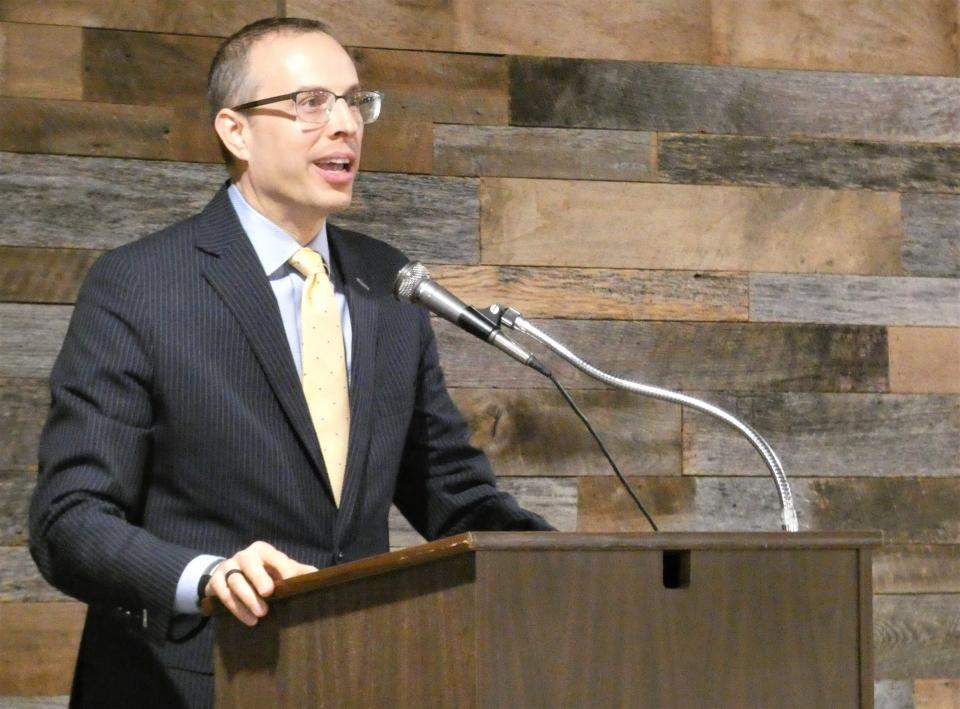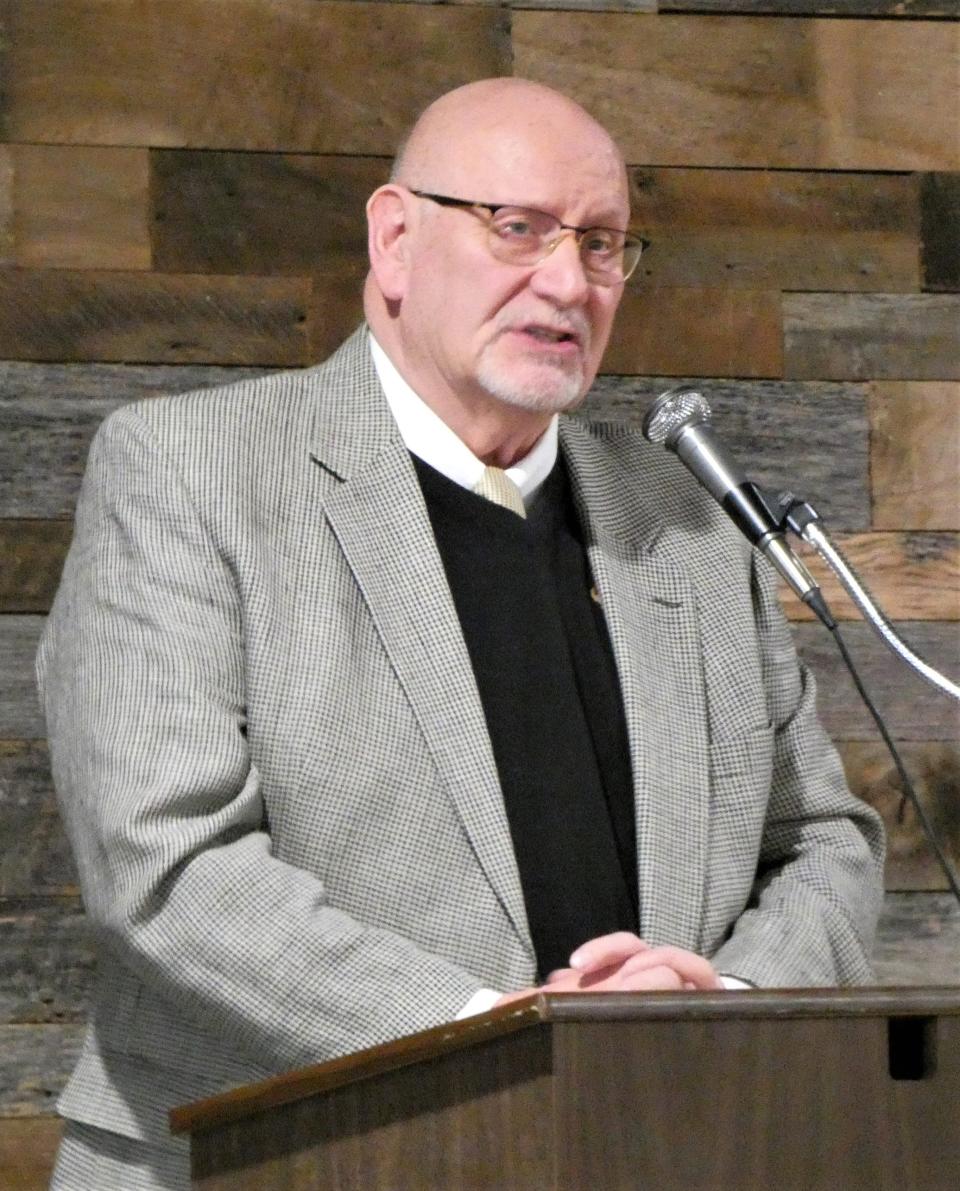Forecast breakfast speaker: 'Fundamentally, the economy is very, very strong'

The annual forecast breakfast presented by the county's two chambers of commerce offered good news and "not-so-good" news, warnings and encouragement, honors and explanations.
For the third year, the Bucyrus Area Chamber of Commerce and the Galion-Crestline Area Chamber of Commerce teamed up for the Crawford County Business Forecast and Economic Development Update, which took place Wednesday morning at The Venue at Old 30, 1325 E. Mansfield St.
Roughly 200 people attended the event, according to Averee Richardson, executive director of the Bucyrus chamber. The nine speakers included "the tried and true to offer continuity, but then we have a few new faces," she said.
"While the road ahead does not appear inviting, Crawford County will continue to prevail because of our one-of-a-kind sense of community and our love of local business," she told the crowd in her opening remarks.
Here are some highlights from the morning's speakers:
● David Zak, executive and economic development director of the Crawford Partnership for Education and Economic Development: With its 42,000 residents, Crawford County is considered one of the nation's 543 micropolitan communities by the U.S. Census Bureau. "We rank Number 293, so we're in the middle of the middle," he said. "As I like to say, we're small, but significant."
Zak first outlined the "not-so-good news" about the county. Since 2011, the number of businesses in the county has increased 3%; but statewide, that figure has increased 9%. Other similar counties in the region of similar size have the same problem. But unlike in other counties, the manufacturing segment has declined in Crawford County, he said. Ten years ago, one in three people worked in manufacturing; that has dropped to one in five; "20% of the manufacturing businesses in this county are no more, and we've had probably a 38% decline in manufacturing employment."
The population is aging and the labor force shrinking, he added. The unemployment rate is at 5%.
"So what's the good news?" Zak asked. "The good news is that we are doing really well. Fundamentally, the economy is very, very strong. We've got 1,400 business establishments that are producing an annual economic activity level of $2.5 billion, with a 'B.'"
Even though the manufacturing segment is smaller, it remains twice as strong as the U.S. average, "with particular strengths in wood products manufacturing, transportation equipment, machinery manufacturing as well as fabricated metals."
The health care sector also is "extremely strong." A decade ago, 13% of the county's employment was in health care; now, it's 20.5%, tied with manufacturing.
Crawford County ranks fourth in the state for agriculture, he said — $250 million, or 10% of the county's entire economy, is driven by agriculture.
While the population continues to age, it's growing for the first time since 1970, he said; and while unemployment is higher than in many surrounding counties, it's "declining significantly."

Zak also cited "very, very strong" economic development activity, with five major projects last year and more in the pipeline for this year.
● Jim Spreng, principal of Spreng Capital Management: "2023 is all about inflation and interest rates; there's no question about that," he said.
The current inflation has nothing to do with politics, Spreng stressed; "This is 100% due to COVID and the pandemic."
"We ended up with increased demand and decreased supply. So, guess what? It's an economic thing, Eco 101 ... you end up with inflation on this," Spreng said, adding the Russian invasion of Ukraine also has been a factor.
Long term, moving manufacturing back to the United States will mean higher costs and a higher rate of inflation, Spreng warned — it's more expensive to make things in the U.S.
Currently, inflation is running between 5% and 7%, he said. "Every single time the United States has had inflation over 5%, we have had a recession," he stressed.
"I think the question about this one is can we have a recession when we have full employment? The job numbers in January were extraordinary — 517,000 new jobs. ... that's a huge number," he said. "Can we really have a recession — even though interest rates are rising — can we have a recession with full employment? The jury's out; we've never been in that position before."

The real question will be up to employers, Spreng said: "Will you lay people off with a coming recession, knowing how difficult it has been for you to find these people and to employ them in the first place? Will you lay them off, or will you do everything in your power to keep them employed, knowing full well if you lay them off, you may never get them back."
● Dwayne Castle, owner of Buckeye Workforce Development and Coaching: Employers tell him they can't keep good-quality workers, he said. "Most of the time, that's followed with 'They're just lazy and they don't want to work,'" he added — but that's not true.
He outlined the growth of the gig economy since 2008, noting that Ohio is ranked eighth in the nation for its number of gig-workers.
"It's not that Americans are lazy and don't want to work; it's that they want to work on their terms; they want to work where they feel valued; they want to work where their priorities and principles are taken seriously, and where they have some control over their destinies," he said. "The priorities of today's workers are different that the prior generation.
"As a nation, younger workers aren't getting married at the same rates; they're having fewer kids; and the stuff they accumulate is cheap and disposable. They don't need the jobs that previous generations did. And they're done with traditional time in exchange for money models. So the state of the workforce is this: Employers who continue to see workers as a tool to get the job done and only offer hours in exchange for a paycheck are going to continue to watch the revolving door spin. And should this recession necessitate layoffs, getting them back's going to be even harder than it was post-COVID. Those employers who see their employees first as humans and then as resources and who deliver an employment experience that genuinely values the person, they're going to fare much better than those who don't."
● Miranda Jones, executive director of the Galion-Crestline Chamber: "We need to work to keep those entering the workforce right here. We start by continuing to collaborate and connect our county's students with our county's businesses."
The most in-demand jobs are in the fields of health care, manufacturing and agriculture — all sectors desperately in need of employees, Jones noted. Other challenges include a lack of child care and transportation.
"This may by far be the most challenging year yet. Extra benefits are being slowly phased out; cost pressures on our businesses continue to rise as we all have seen supply costs rise. We will see our businesses struggle this year. We need to stay together and work collaboratively to push our county forward."
● Katie Rafeld, public health educator for Crawford County Public Health, outlined the many topics she addresses as she speaks to a variety of audiences in her job. But she said the topic she's most passionate about is QPR, or Question-Persuade-Refer, a suicide prevention program.
"That is the one life-saving skill that if we all had that one hour of free training, we could wrap our arms around Crawford County and help each other," she said. She also spoke about 988, the national crisis phone number that was introduced last year.
● Amber Wertman, executive director of the United Way of North Central Ohio, presented her organization's Red Feather Award to Ohio Mutual Insurance Group.
The award is presented to "local change-makers who deliver overwhelming service to the community through strategic philanthropy, volunteerism and advocacy of service over self," Wertman said.
Other speakers included Kevin Fourman, Mid-Ohio Educational Service Center; Mark Rantala, Economic Development Opportunity Advisors and Galion Port Authority; Dawn Ratliff, ADM Benefit Plans Agency, Inc; and Dustin Ritchie, Magnificent Maid.
Mary Jo Carle of Together We Hurt Together We Heal provided Narcan training following the event.
ggoble@gannett.com
419-559-7263
This article originally appeared on Bucyrus Telegraph-Forum: Forecast breakfast speakers focus on local economy, job market

